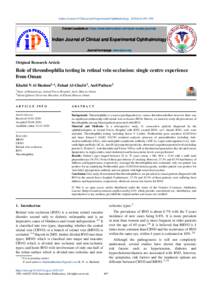وثيقة
Role of thrombophilia testing in retinal vein occlusion : single centre experience from Oman.
المعرف
DOI: 10.18231/j.ijceo.2020.107
المصدر
Indian Journal of Clinical and Experimental Ophthalmology. v. 6, 4, p. 497-500
المساهمون
Al-Ghafri, Fahad., مؤلف
Pathare, Anil., مؤلف
الدولة
India
مكان النشر
Delhi
الناشر
IP Innovative Publication Pvt. Ltd.
ميلادي
2020-01-01
اللغة
الأنجليزية
الموضوع
الملخص الإنجليزي
Background: Thrombophilia is a known predisposition to venous thromboembolism however there was no significant relationship with retinal vein occlusion (RVO). Herein, we aimed to study the prevalence of thrombophilia among Omani patients presented with RVO. Material and Methods: In a retrospective study, 11 consecutive patients diagnosed by the ophthalmologists at Armed Forces Hospital with RVO (central RVO, n=7; branch RVO, n=4) were included. Thrombophilia testing including factor V Leiden, Prothrombin gene mutation (G20210A) and Janus Kinase-2 (JAK2 V617F) mutation analysis; presence of autoantibodies including Anti-nuclear antibody(ANA), Anti-neutrophil cytoplasmic antibody (ANCA), Lupus anticoagulant (LA), Anti cardiolipin antibody (ACA), Anti-B2 glycoprotein positivity; abnormal coagulation protein levels including protein S, Protein C, Anti-thrombin and Factor VIII as well as biochemical parameters like elevated serum lipoprotein 1a, triglycerides, total cholesterol and homocysteine levels were performed. Results: Patient’s ages ranged between 25 to 75 years (mean + SD; 48.8 + 13.6) with a mild male preponderance (54.5%). None of them gave history of smoking. However, 27.3% and 45.5% had history of diabetes and hypertension, respectively. Amongst the thrombophilia tests evaluated, only one patient was positive for an underlying Prothrombin gene (G20210A) heterozygosity, another patient was positive for Anti-beta2 glycoprotein antibody and one patient with high serum homocystine. Conclusion: Our study demonstrated that thrombophilia is not prevalent in omani patients diagnosed with RVO in the armed forces hospital. Furthermore, 27.3% and 45.5% of those patients were suffering from diabetes and hypertension, respectively which are known risk factors for RVO.
ISSN
2395-1443
قالب العنصر
مقالات الدوريات

